LIGO Scientists Detected A Third Gravitational Wave From Two Colliding Black Holes.

LIGO scientists detected a third gravitational wave from two colliding black holes.
This week, scientists using the Laser Interferometer Gravitational-Wave Observatory, or LIGO, announced that they had detected another gravitational wave—the third ripple observed since September 2015. The findings were published in the journal Physical Review Letters.
The source of this most recent gravitational wave is a black hole 49 times larger than our sun that was formed by two colliding black holes located 3 billion light-years away. The data indicates that the spin of one or both of the black holes may have a tilted orbit, which can reveal clues to their origins. Theoretical astrophysicist Priyamvada Natarajan explains how this finding sheds light on black hole formation, and how it affects our understanding of general relativity and dark matter. Listen here.
[Image credit: LIGO/Caltech/MIT/Sonoma State (Aurore Simonnet)]
More Posts from Hannahhaifisch and Others



Drafts of tessellations…
Triphilia by Robin Scholz, Star/Flower, star side, by Lydia Diard.
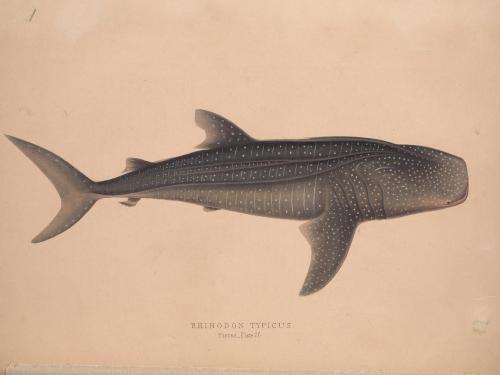




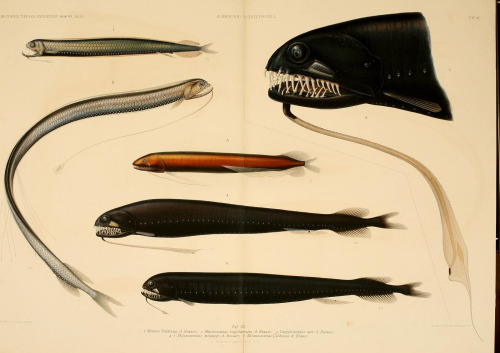
June 8th is World Oceans Day - a day to celebrate the oceans that connect and sustain all of us. Our colleagues at the Biodiversity Heritage Library have been leading up to today with a series of blog posts exploring historic publications that mark important milestones in the progress of marine bioscience research and ocean exploration.
Top image: Whale shark from Illustrations of the zoology of South Africa… v.4 (1845) Middle top : radiolarians and jellyfish from Ernst Haeckle’s Kunstformen der Natur (1904) Middle bottom: giant squid from Cassell’s Natural History v.5-6 and cuttlefish from Voyage de la corvette l'Astrolabe Mollusques and Zoophytes Atlas (1833) Bottom: deep sea fish from Valdivia Expedition…1898-1899. Bd. 15, T. 1

0009



Many solids can dissolve in liquids like water, and while this is often treated as a matter of chemistry, fluid dynamics can play a role as well. As seen in this video by Beauty of Science, the dissolving candy coating of an M&M spreads outward from the candy. This is likely surface-tension-driven; as the coating dissolves, it changes the surface tension near the candy and flow starts moving away thanks to the Marangoni effect. With multiple candies dissolving near one another, these outward flows interfere and create more complex flow patterns.
These flows directly affect the dissolving process by altering flow near the candy surface, which may increase the rate of dissolution by scouring away loose coating. They can also change the concentration of dissolved coating in different areas, which then feeds back to the flow by changing the surface tension gradient. (Video and image credit: Beauty of Science)


Tetrahedrite with Siderite
Locality: Saint-Pierre-de-Mesage, Vizille, Rhone-Alpes, France

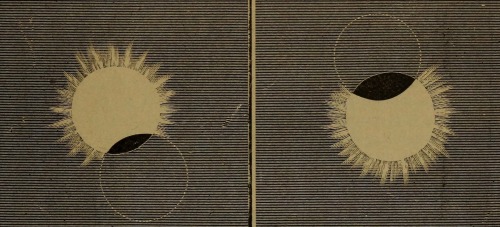
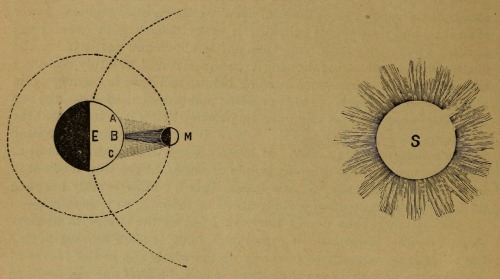


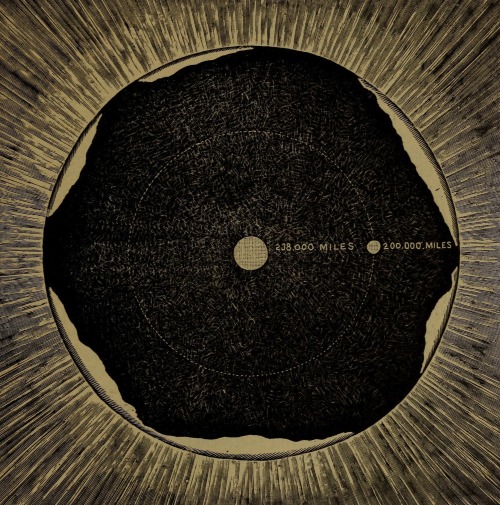

Samuel W. Hall. Corona of an Eclipse, Moon Hiding Lower and Upper Limb of Sun, Eclipse of the Sun, Moon Hiding Upper and Lower Limb of Sun, Comparative Size of the Planets, Size of the Sun, Elliptical Orbit. Sunshine and Moonlight; with; also, a Flash of Comets, Meteors and Shooting Stars, and a Twinkle of Starlight. 1889. Contd from here


Galena and Fluorite - Blackdene Mine, Ireshopeburn, Weardale, Co. Durham, England

Sand and water make a remarkable team when it comes to building. But the substrate – the surface you build on – makes a big difference as well. Take a syringe of wet sand and drip it onto a waterproof surface (bottom right), and you’ll get a wet heap that flows like a viscous liquid. Drop the same wet sand onto a surface covered in dry sand (bottom left), and the drops pile up into a tower. Watch the sand drop tower closely, and you’ll see how new drops first glisten with moisture and then lose their shine. The excess water in each drop is being drawn downward and into the surrounding sand through capillary action. This lets the sand grains settle against one another instead of sliding past, giving the sand pile the strength to hold its weight upright. (Video and image credit: amàco et al.)

-
 ladytimetraveller liked this · 7 years ago
ladytimetraveller liked this · 7 years ago -
 20thcen reblogged this · 7 years ago
20thcen reblogged this · 7 years ago -
 tolmuhol-blog liked this · 7 years ago
tolmuhol-blog liked this · 7 years ago -
 20thcen reblogged this · 7 years ago
20thcen reblogged this · 7 years ago -
 mmyyame liked this · 7 years ago
mmyyame liked this · 7 years ago -
 basedassseal reblogged this · 7 years ago
basedassseal reblogged this · 7 years ago -
 solacemagna liked this · 7 years ago
solacemagna liked this · 7 years ago -
 pinkheartfest liked this · 7 years ago
pinkheartfest liked this · 7 years ago -
 timesandteacups reblogged this · 7 years ago
timesandteacups reblogged this · 7 years ago -
 timesandteacups liked this · 7 years ago
timesandteacups liked this · 7 years ago -
 asdl1238-blog liked this · 7 years ago
asdl1238-blog liked this · 7 years ago -
 helloacabreuworld-blog liked this · 7 years ago
helloacabreuworld-blog liked this · 7 years ago -
 dman04321 liked this · 7 years ago
dman04321 liked this · 7 years ago -
 b-g-b-g-b-a-l reblogged this · 7 years ago
b-g-b-g-b-a-l reblogged this · 7 years ago -
 cindyfalvo-blog liked this · 7 years ago
cindyfalvo-blog liked this · 7 years ago -
 javierale123 liked this · 7 years ago
javierale123 liked this · 7 years ago -
 patterncrystal reblogged this · 7 years ago
patterncrystal reblogged this · 7 years ago -
 syshines-blog liked this · 7 years ago
syshines-blog liked this · 7 years ago -
 tango-smarts reblogged this · 7 years ago
tango-smarts reblogged this · 7 years ago -
 bedroom-tango liked this · 7 years ago
bedroom-tango liked this · 7 years ago -
 cripplenipple liked this · 7 years ago
cripplenipple liked this · 7 years ago -
 diceablog liked this · 7 years ago
diceablog liked this · 7 years ago -
 flamingpuppeteer liked this · 7 years ago
flamingpuppeteer liked this · 7 years ago -
 xicat-blog liked this · 7 years ago
xicat-blog liked this · 7 years ago -
 kotonechan32 liked this · 7 years ago
kotonechan32 liked this · 7 years ago -
 curioustechie-blog1 liked this · 7 years ago
curioustechie-blog1 liked this · 7 years ago -
 adityasoni212 liked this · 7 years ago
adityasoni212 liked this · 7 years ago -
 wishn liked this · 7 years ago
wishn liked this · 7 years ago -
 panda-of-the-trashh reblogged this · 7 years ago
panda-of-the-trashh reblogged this · 7 years ago -
 panda-of-the-trashh reblogged this · 7 years ago
panda-of-the-trashh reblogged this · 7 years ago -
 panda-of-the-trashh liked this · 7 years ago
panda-of-the-trashh liked this · 7 years ago -
 francis52600 liked this · 7 years ago
francis52600 liked this · 7 years ago -
 megasassmonster reblogged this · 7 years ago
megasassmonster reblogged this · 7 years ago -
 tarquinfurie reblogged this · 7 years ago
tarquinfurie reblogged this · 7 years ago -
 lovethatcoat liked this · 7 years ago
lovethatcoat liked this · 7 years ago -
 themadtargaryens liked this · 7 years ago
themadtargaryens liked this · 7 years ago -
 intergalacticunicornqueen liked this · 7 years ago
intergalacticunicornqueen liked this · 7 years ago -
 twistedsardonic reblogged this · 7 years ago
twistedsardonic reblogged this · 7 years ago -
 darthvaporwave reblogged this · 7 years ago
darthvaporwave reblogged this · 7 years ago -
 sleepyheathen reblogged this · 7 years ago
sleepyheathen reblogged this · 7 years ago -
 neeransh-blog1 liked this · 7 years ago
neeransh-blog1 liked this · 7 years ago